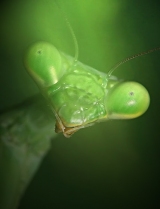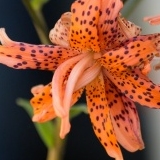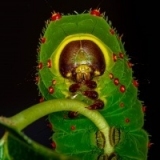- Forum
- Photography and Camera Forum
- Photo Galleries - For General Display or Critique
- Macro Photography
- What is Macro Photography?
What is Macro Photography?
-
 Topic Author
Topic Author
- dang
- Snapobsessed
-
- Primarily Canon, but I've owned and shot with everything from 110 to 8x10.
- Followers: 65
- Posts: 434
-
Points:
32
Post #198251
However, with the advances in lens design, lenses now focus within inches of their subject, so a macro image is considered "true macro" when the subject is the same size (or larger) on a 35mm full frame (24x36mm) as it is in real life. Anything less than 1:1 magnification is considered "Close Up". And while this probably isn't going to win me any friends, it needs to be said: Cropping an image of less than 1:1 does not make it macro. While there are circumstances where cropping is needed, such as when having a circular frame if using a reversed lens, or to help composition... there are several things to consider before cropping your shots.
Why Are My Insect Photos Blurry Looking?
There can be numerous reasons, though the most common is over-cropping. Improper exposure, or shutter speeds which are too slow, often referred to as Motion blur can also play part. If hand-holding your camera, keep the shutter at least as fast as the millimeter of the lens used. This depends greatly on your steadiness, so increasing ISO allows using faster speeds and improves chances. DSLR sensors have come a long way over time, so don’t be afraid to try higher ISO, at least to check. And when shooting macro, remember motion is exaggerated even more due to the closeness of your subject to lens, so even shorter shutter speeds will render better results.
Why Is My Depth Of Field So Shallow?
Increasing magnification always decreases DOF for any given aperture. Depending on magnification amount, depth of field can be paper thin. This is why we usually “Stop Down” the aperture. However, there are limits. Lenses of all types are sharpest when aperture is closed one, or two stops from open. Going beyond, and lens diffraction begins adding distortion. For all types of photography, f/8 to f/11 generally gives a reasonable compromise between dof and clarity. Allow subject size, and creativity to decide.
Are There Other Ways To Increase DOF?
The most common way is to “Stack” photos. You make exposures at various focus points and use a program to combine them, so it's usually done under controlled conditions. I only photograph live bugs, so it's not something I use. And since it requires heavy manipulation of the final image, I consider it more useful to photographers with good Photoshop skills. Combine Z is a good program to get started. Check instructions and compatibility for your computer.
Can I Use A Tripod, Or Flash When Photographing Insects?
Many people use tripods with great success, but you need extreme patience. If possible, set up and wait for insects to come to you since movement scares bugs away. Focus on a flower, and use a cable release, or remote to trip the shutter when insects move into the focused area. If possible, using mirror lock-up also reduces camera vibration which can blur your shot.
However, Flash allows the easiest alternative, and improves results due to it stopping motion. Flash syncs with your camera at 1/200, or 1/250th a second in aperture priority, depending on camera make and body type. But the flash duration is much shorter. Flash sync speed can be set on most Canon bodies via the custom function menu. This allows simply setting your desired f/stop to gain dof, and the exposure is automatically adjusted. However, because the flash exposes for the primary subject only, you usually find you have black backgrounds. This can be controlled by using manual settings, and/or metering for the background. Meter the background around one stop under for a natural look, and your flash will do the rest. Keep shutter speed at, or a little below sync speed. And by watching background, you can include elements close to the subject which are easier lighted, or include bright green areas that blend well. Try avoiding excessive clutter, and over-bright “background hot-spots” that distract, and use minimum f/stop to blur background elements while keeping enough dof for the subject.
Photographing Insects
Some species of insects come to bait, such as sliced fruit, or raw meat. Or mix a teaspoon of honey in warm water and spray on leaves, but beware, plants and flowers wilt in a few hours from honey. You can also capture bugs in a jar, and set in a refrigerator for around 30 minutes, the insect will slow down and can be photographed inside. Avoid poisonous spiders, or wasps of any type. When photographing bees or ants, focus in front of them, and allow them to come to you. Avoid Wasps especially in the Fall when they can be extremely aggressive, but use caution always. Most of all, take lots of photos, get creative and have fun.
Basic Equipment Requirements To Photograph Insects
Equipment will vary greatly depending on the intended use of your photographs. If you only post on the web, a point and shoot camera with macro functions could be all you need. And while trimming your photos is not always a bad thing, work within the limits of what you have. For web display, trimming photos can increase detail if done conservatively. But if cropped too much, noise is increased, and detail suffers. And while Noise Reduction programs can be helpful, avoid over-processing which adds “halo” or smudges tiny hairs.
Of course, if needing large file sizes for printing, the only option is to increase magnification, and here is where a DSLR, and macro lens deserves consideration. Nothing beats a true macro lens with a set of extension tubes, converter, or a Canon MPE 65mm 1-5X macro lens for bringing out detail. Once you go beyond life size magnification, insects eye facets and hair become clear. And until you see your bug shots enlarged to 20 X 30” or more, you haven’t experienced the joy high pixel counts of newer digital cameras offer.
Insanity: doing the same thing over, and over again expecting different results. (Albert Einstein)
www.dangphoto.weebly.com
-
 Topic Author
Topic Author
- dang
- Snapobsessed
-
- Primarily Canon, but I've owned and shot with everything from 110 to 8x10.
- Followers: 65
- Posts: 434
-
Points:
32
Post #198354
Bubbles wrote: WOW, thanks for the detail explanation on macro photography.
Thank you for looking, Bubbles. Hope you found it helpful.
Insanity: doing the same thing over, and over again expecting different results. (Albert Einstein)
www.dangphoto.weebly.com
Post #198357
“Amateurs worry about equipment, professionals worry about money, masters worry about light, I just make pictures… ” ~ Vernon Trent
-

- bigbubbaG
- Photography Hooked
-
- Canon Rebel T2i
- Followers: 11
- Posts: 634
-
Points:
0
Post #198405
Thanks again, G
Victory is won not in miles but inches. Win some, hold your ground, win some more.
---Louis L'amour
-

- Hussain Al Mousa
- Lone Wolf
-
- Nikon D300s
- Followers: 8
- Posts: 177
-
Points:
0
Post #213580
I am just a guy with a camera...
-

- Baydream
- Moderator
-
- Canoni/60D/70D/5DmkIII
- Followers: 388
- Posts: 11185
-
Points:
7280
Post #213635
Shoot, learn and share. It will make you a better photographer.
fineartamerica.com/profiles/john-g-schickler.html?tab=artwork
-

- TabbyWithIt
- New Kid On The Block
- Canon EOS 60D
- Followers: 0
- Posts: 15
-
Points:
0
Post #220607
-

- Rita Sow
- Photo Guru
- Followers: 720
- Posts: 3321
-
Points:
33210
-
 Pt+
Pt+ - stuartsbarbie
- Photography Hooked
-
- Cannon 6d
- Followers: 568
- Posts: 519
-
Points:
2004
Post #432800
-

- Screamin Scott
- Moderator
-
- Nikon D610, Nikon D7100, Nikon D300, Olympus OMD E-M5 MarkII, Olympus OM-D E-M10, Olympus Pen E-P3 + film SLR's
- Followers: 1384
- Posts: 6866
-
Points:
40251
Post #432805
-

- r1ch
- Banned
- Followers: 66
-
Points:
5752
-

- r1ch
- Banned
- Followers: 66
-
Points:
5752
Post #735405
dang wrote:
However, with the advances in lens design, lenses now focus within inches of their subject, so a macro image is considered "true macro" when the subject is the same size (or larger) on a 35mm full frame (24x36mm) as it is in real life. Anything less than 1:1 magnification is considered "Close Up". And while this probably isn't going to win me any friends, it needs to be said: Cropping an image of less than 1:1 does not make it macro. While there are circumstances where cropping is needed, such as when having a circular frame if using a reversed lens, or to help composition... there are several things to consider before cropping your shots.
Yeah well you were not my friend to begin with and I like you even less now for your snobbish comment.
At least 2 manufacturers, maybe more, have lenses that are not 1:1 and yet have the macro designation.
That is your opinion and is not the definition of macro. Lets define macro. According to Marion Webster dictionary.. 4 : of or relating to a macro lens or to close-up photography.
Macro is close up photography. It does not have to be a macro lens and it does not have to be 1:1. Period. That is your opinion and there is no standard that says you must pass some scrutiny or particular lens. I can take a 28-135
Canon lens and put 2 extension tubes on it and it becomes over 1:1, it
is not a macro lens. If you take a image and you crop it and print it larger than life. It is macro. So any close up shots are macro and they don't even have to meet 1:1.. . According to the dictionary. You may have your own qualifications but they have no bearing on the word or definition of macro or what macro photography is.
All my macro images use a 100mm Canon lens that is 1:1, sometimes I will add a telephoto converter to it or and extension tube or even a Raynox DCR-250 Super Macro Snap-On Lens. But if I don't shoot at the minimum focus distance the image is still not 1:1, so you would consider this a close up but not macro. That is about the most snobbish thing I have heard in a while. That is your opinion at best and is totally wrong at worst. There is no ANSI standard or organization that has created a macro standard and even the lens manufactures create lenses called macro that are not 1:1 Do you really buy the bs you are selling?
- Forum
- Photography and Camera Forum
- Photo Galleries - For General Display or Critique
- Macro Photography
- What is Macro Photography?
Latest Reviews
The Olympus Pen E-P7 is an affordable micro four thirds mirrorless camera with 4K video capabilities, a 20.3MP sensor, and 121 focus points, making it a solid entry-level camera for beginners.
The Panasonic G9 II is a 25.2-megapixel micro four thirds camera with numerous features that make it punch out of its weight class, like 779 AF points, 5.8K video, and weather sealing.
The Fujifilm XT5 is a 40MP mirrorless camera capable of 6.2K video at 30p. With those specs, it’s an ideal choice for photographers needing a camera to pull double duty for imaging and video.
The Canon EOS R100 is an entry-level mirrorless camera introduced in 2023. But just because it’s an entry-level camera doesn’t mean it’s a bare-bones camera. Find out why in this review!
Forum Top Posters
-
1Alyssa Briggs 2 posts
-
2Sonder 2 posts
-
3Jin Hyuk Kwon 2 posts
-
4Jack Mason 1 post
-
5Screamin Scott 1 post
Latest Articles
In this guide to the bokeh effect, you’ll learn what bokeh is and the factors involved in creating it. You’ll also explore some beautiful example images to spark your creativity with bokeh!
Upgrade your kit in 2024 with the best intermediate camera on the market! The question is, what camera fits the bill? We’ve got three top options for you to choose from in this buyer’s guide.
The best photography jobs right now are a mix of tried-and-true gigs like wedding photography and new jobs highlighting AI’s capabilities, travel, and videography.
The Olympus Pen E-P7 is an affordable micro four thirds mirrorless camera with 4K video capabilities, a 20.3MP sensor, and 121 focus points, making it a solid entry-level camera for beginners.
Starting a photography business is one thing; sustaining your business over a long period of time is another. Use the tips in this professional photography guide to build something with longevity!
The Panasonic G9 II is a 25.2-megapixel micro four thirds camera with numerous features that make it punch out of its weight class, like 779 AF points, 5.8K video, and weather sealing.
Cinematic photography is an interesting genre that combines photographic and videographic skills along with effective storytelling techniques. The result? Highly impactful images!
Newborn photography requires skill, the right gear, and a lot of patience. This beginner’s guide discusses critical topics that will help you be more prepared for before, during, and after the shoot.
















